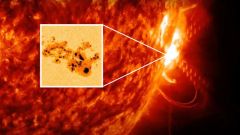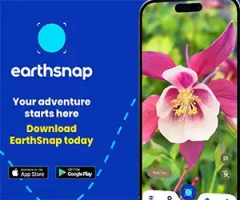Space

Jan 9th, 2026 - It's quick and easy to access Live Science Plus, simply enter your email below. We'll send you a confirmation and sign you up for our daily newsletter, keeping you up to date with the latest science news. The massive sunspot that sparked an "extreme" geomagnetic storm in May 2024 unleashed hundreds of other dangerous solar flares, including a hidden X-class outburst, a new paper reveals. The study sets a record for the longest continuous observation of a single active region on our home star. ... [Read More]
Source: livescience.com

Jan 9th, 2026 - Cosmic dust makes up a large part of the universe and is a solid companion to galaxies. For the longest time, astronomers believed there was a fixed recipe that formed these dust grains. A recent observation by NASA's James Webb Space Telescope made an astonishing discovery. Apparently, heavy elements—previously believed to be the main ingredients—are not essential to form dust grains. Scientists studied the dwarf galaxy Sextans A, one of the earliest or primitive known galaxies ... [Read More]
Source: greenmatters.com

Jan 9th, 2026 - Reading time 3 minutes Since its launch in 1990, Hubble has transformed our understanding of the cosmos. The space telescope revealed a universe teeming with galaxies, stars, and planets instead of what we once saw as empty patches of the skies. Today, the telescope's aging hardware is being dragged down toward Earth, and Hubble may be nearing its end sooner than anticipated. A team of scientists has estimated that the Hubble Space Telescope could reenter Earth's atmosphere and meet its fiery ... [Read More]
Source: gizmodo.com

Jan 9th, 2026 - Supermassive black holes are notorious for gobbling up young stars and burping out powerful jets of gas as they finish the snack. Scientists call this mechanism "jet precession." Typically, only two types of jet streams are observed by the astronomers during this process. One is the radiative mode where a white-hot incandescent accretion disk heats up the gassy material, and the superheated gas pushes out the cooler gas outwards. Another mode, as Scientific American describes, sees ... [Read More]
Source: greenmatters.com

Jan 9th, 2026 - Sky This Week is brought to you in part by Celestron. Friday, January 9 Mars is in conjunction with the Sun at 7 A.M. EST, invisible in our sky until mid-March. The bright moon Titan lies near its parent world, Saturn, in the evening sky tonight. The largest of the ringed planet's moons, Titan is the only other solar system world known to host liquid on its surface, though its lakes and seas consist of hydrocarbons (like ethane and methane), not water. The second-largest moon in ... [Read More]
Source: astronomy.com

Jan 9th, 2026 - A spiral galaxy's nucleus, carved by an elongated plume of gas and stars, creates a bar-like structure at the center. These galaxies are called barred spiral galaxies, as per NASA . Recent research led by Daniel Ivanov, a physics and astronomy graduate student in the Kenneth P. Dietrich School of Arts and Sciences at Pitt, may have found its earliest member. In a potentially groundbreaking discovery, the researchers seem to have uncovered one of the earliest spiral galaxies of the universe with ... [Read More]
Source: greenmatters.com

Jan 8th, 2026 - New research gives us the answer many have been long wondering. Astronomers have cataloged thousands of exoplanets, and a pattern keeps showing up: Around most stars, the most common planets are bigger than Earth but smaller than Neptune. They're often called super-Earths and sub-Neptunes , and dominate the statistics. But are these really the most common types of planets? Now, a new Nature study points to an answer by catching four planets at a stage most systems never show us: The awkward, ... [Read More]
Source: zmescience.com

Jan 8th, 2026 - It's quick and easy to access Live Science Plus, simply enter your email below. We'll send you a confirmation and sign you up for our daily newsletter, keeping you up to date with the latest science news. Facebook X Whatsapp Reddit Flipboard Join the conversation Add us as a preferred source on Google Newsletter Subscribe to our newsletter A shock wave, far away in space, might be the telltale sign of the first confirmed "runaway" supermassive black hole , escaping its host galaxy at 2.2 ... [Read More]
Source: livescience.com

Jan 8th, 2026 - Could this be a gateway to subterranean shelters for future explorers? Scientists have discovered a mysterious hole on the surface of Mars, and they have no idea what lies inside it. This pit, located in the Arsia Mons region — one of Mars' giant volcanoes — could potentially be a skylight leading to a vast network of lava tubes. Lava tubes are natural caverns formed by flowing lava. Here on Earth, they provide shelter for many life forms, and on Mars, they could offer human ... [Read More]
Source: zmescience.com

Jan 8th, 2026 - "This is now the fastest-spinning asteroid that we know of, larger than 500 meters [1,640 feet]," astronomer Sarah Greenstreet revealed at the recent American Astronomical Society's winter meeting held in Phoenix. Named 2025 MN45, the asteroid was discovered by the NSF–DOE Vera C. Rubin Observatory, and it makes a full rotation every 1.88 minutes. It has been declared as the asteroid that rotates faster than any other asteroid of that size (nearly half a mile in diameter). Its discovery ... [Read More]
Source: greenmatters.com

Jan 8th, 2026 - Science Inside Donald Trump's Attack on NASA's Science Missions During his first year back in office, the president tried to bring America's age of discovery to an end. A test model of the Perseverance rover, designed to explore the surface of Mars, sits in a garage at NASA's Jet Propulsion Laboratory, near Pasadena, California, in October. Save O n Mars , in the belly of a rover named Perseverance, a titanium tube holds a stone more precious than any diamond or ruby on Earth. The robot spotted ... [Read More]
Source: theatlantic.com

Jan 7th, 2026 - Follow Earth on Google NASA's Perseverance rover has spotted a desk-sized rock, nicknamed Phippsaksla, on Mars that looks suspiciously like an iron-rich meteorite. Roughly 31 inches wide (80 centimeters) wide, the lonely boulder sits in the Vernodden area just beyond Jezero Crater. Metal-rich Phippsaksla rock The work was led by Candice Bedford, a research scientist at Purdue University , whose studies focus on Martian rocks. The unusual Phippsaksla rock has a sculpted shape and raised position ... [Read More]
Source: earth.com

Jan 7th, 2026 - It's quick and easy to access Live Science Plus, simply enter your email below. We'll send you a confirmation and sign you up for our daily newsletter, keeping you up to date with the latest science news. Facebook X Whatsapp Reddit Flipboard Join the conversation Add us as a preferred source on Google Newsletter Subscribe to our newsletter Half a year after first opening its eyes to the cosmos, NASA 's SPHEREx spacecraft has unveiled its first complete, all-sky mosaic of the universe. The first ... [Read More]
Source: livescience.com

Jan 7th, 2026 - Follow Earth on Google Betelgeuse is a massive red star that's easy to spot in the night sky. Located on Orion's shoulder, it glows red and oversized compared with most stars. For as long as astronomers have observed it, Betelgeuse has shown noticeable changes rather than steady, predictable behavior. The star's brightness rises and falls, its surface looks lumpy, and its atmosphere stretches far out into space and then shifts again. For years, astronomers have argued over why this happens. ... [Read More]
Source: earth.com

Jan 6th, 2026 - This is a first for planetary researchers. Most planets can be described in at least one respect: They circle a star, making them somewhat easy(ish) to find. A transit dips the star's light. A wobble nudges the star's spectrum. Even a direct image, rare as it is, usually leans on the star's glare and the planet's reflected or thermal glow. However, a free-floating (or "rogue") planet offers none of that. It drifts through a galaxy without an obvious host star, cold and dark enough to blend into ... [Read More]
Source: zmescience.com

Jan 6th, 2026 - It's quick and easy to access Live Science Plus, simply enter your email below. We'll send you a confirmation and sign you up for our daily newsletter, keeping you up to date with the latest science news. Facebook X Whatsapp Reddit Flipboard Join the conversation Add us as a preferred source on Google Newsletter Subscribe to our newsletter Astronomers have spotted an unexpectedly hot galaxy cluster in the early universe that's challenging theories of galactic evolution. The scorching cluster ... [Read More]
Source: livescience.com